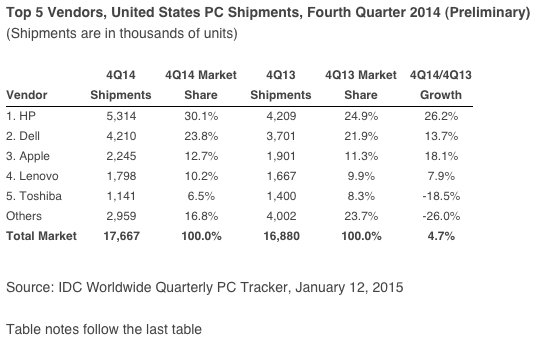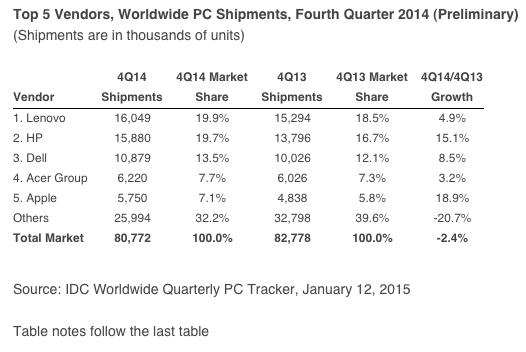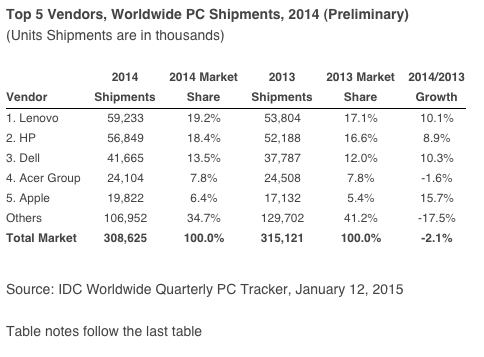Apple Maintains Number Five (No. 3 IN U.S.) PC-Maker Status, Grows Market Share in Q4 2014 – IDC
According to International Data Corporation (IDC)’s latest Worldwide Quarterly PC Tracker report, worldwide PC shipments totaled 80.8 million units in the fourth quarter of 2014 (4Q14), represeting a year-over-year decline of -2.4%. A positive note is that total shipments were slightly above expectations of -4.8% growth, but the market still contracted both year ov year and in comparison to the 2014 third quarter.
Notw that IDC defince “PC” as including Desktops, Portables, Ultraslim Notebooks, Chromebooks, and Workstations, but not \ handhelds, x86 Servers and Tablets (i.e. iPad, or Tablets with detachable keyboards running either Windows or Android).
The 2014 holiday quarter saw shipment volume climb above 80 million for the first time in, but the year’s final quarter nonetheless marked the end of yet another difficult year – the third consecutive with overall volumes declining. On an annual basis, 2014 shipments totaled 308.6 million units, down -2.1% from the prior year.
According to the report, although the U.S. and Europe remained stronger than other markets, growth in these mature regions slowed from earlier in the year. Asia/Pacific (excluding Japan)(APeJ) continued to strengthen, seeing only a very slight increase in volume as a number of public projects and improving consumer demand helped stabilize the market. Similarly, commercial demand, which boosted growth earlier in the year, has slowed while consumer demand is gradually coming back.
Nevertheless, IDC notes that the market’s progress has been fueled by low-priced systems, including growth of Chromebooks and promotion of Windows 8 + Bing. Constraints on Bing promotions, such as limits on larger-sized devices, could remove a key market driver while some fourth quarter production was attributed to getting ahead of holiday-related production constraints in Asia in the first quarter, effectively shifting volume from early 2015 into the end of 2014.
“The strength from market leaders, as well as improvement in Asia/Pacific and the consumer market more generally, are positive signs for the PC market,” says Loren Loverde, IDC Vice President, Worldwide PC Tracker. “Growth of Chrome, Bing, all-in-ones, ultraslim, convertibles, and touch systems similarly make PCs more compelling and competitive. Nevertheless, some of the gains are relatively small, and weakening drivers like Bing promotions and end of XP support transitions, cast a shadow of doubt on the strength of the market going into 2015.”
“The U.S. PC market continued to grow in the fourth quarter, outperforming the global market for the tenth consecutive quarter. The past year was supported by Windows XP to 7 migrations in the commercial segment while consumer volume continued to decline,” says Rajani Singh, Senior Research Analyst, Personal Computing. “Moving forward, the U.S. PC market should see flat to slightly positive growth. The U.S. consumer PC market will finally move to positive growth in 2015, strengthened by the slowdown in the tablet market, vendor and OEM efforts to rejuvenate the PC market, the launch of Window 10, and replacement of older PCs.”
Regional Highlights
United States – Market leader HP had a remarkable quarter with year on year growth jumping to more than 26%. Other key vendors also had strong performances. As a result, the U.S. PC market concentration has increased to 83% of shipments coming from the top 5 vendors. Portable PC growth remains strong with double-digit growth from a year ago, while desktop shipments declined by more than -10%.
Europe, Middle East, and Africa (EMEA) – PC shipments in EMEA posted a slight increase in the fourth quarter, fuelled mainly by strong consumer demand during the holiday season. Vendors continued to stock up ahead of Christmas and January promotional sales, and before the February change to Bing promotions, which will exclude 15 inch notebooks. This translated into stronger than expected shipments of portable PCs, while desktop PC sell-in remained softer, particularly in the commercial space. Political and economic factors, especially unfavourable exchange rates, also negatively impacted numerous countries across the region.
Japan – The market continued to slump following a surge of XP replacements a year ago. Vendors took the time to clear excess inventory in the channel, leading to a lean quarter. Volume fell below 3 million units in the quarter, a drop of -35% year on year and its lowest level since the fourth quarter of 2006.
Asia/Pacific (excluding Japan) – APeJ continued to stabilize with growth rising to positive territory following several years of significant declines. HP had a strong recovery from recent quarters, while Dell continued to gain share. Slowing growth in tablets and smartphones as well as promotions of lower-priced Windows 8 + Bing systems helped relieve some pressure on the PC market.
Vendor Highlights
Lenovo continued to push hard in EMEA, expanding channels and capturing consumer holiday demand. The company also outpaced the market in the U.S. – though by a smaller margin – and was closer to market growth in other regions. Shipments reached a record 16 million units in 4Q14 with year-on-year growth of 4.9%, and annual shipments up over 10% from last year.
HP also saw a tremendous quarter with 15.9 million units and year on year growth surpassing 15%. A particularly strong quarter in the U.S. was a key driver, along with some volume for public projects in Asia/Pacific and Africa.
Dell shipped over 10.8 million units growing 8.5% on the year, much of it based on a strong performance in notebooks in the U.S. and APeJ. Rising growth in APeJ also helped offset slowing growth in the U.S. and Europe.
Acer grew over 3%, in part due to low volume a year ago but also from the success of its Chromebooks and entry-level notebooks. Acer’s recovery in the U.S. and Europe slowed, in part due to higher year ago numbers.
Apple kept the number 5 position on a worldwide basis, maintaining its lead over ASUS. The company’s steady growth, along with recent price cuts and improved demand in mature markets, has helped it to consistently outgrow the market.
Table Notes:
Some IDC estimates prior to financial earnings reports.
Shipments include shipments to distribution channels or end users. OEM sales are counted under the vendor/brand under which they are sold.
PCs include Desktops, Portables, Ultraslim Notebooks, Chromebooks, and Workstations and do not include handhelds, x86 Servers and Tablets (i.e. iPad, or Tablets with detachable keyboards running either Windows or Android). Data for all vendors are reported for calendar periods.
includDesktops, Portables, Ultraslim Notebooks, Chromebooks, and Workstations and do not include handhelds, x86 Servers and Tablets (i.e. iPad, or Tablets with detachable keyboards running either Windows or Android). Data for all vendors are reported for calendar periods.
IDC’s Worldwide Quarterly PC Tracker gathers PC market data in over 80 countries by vendor, form factor, brand, processor brand and speed, sales channel and user segment. The research includes historical and forecast trend analysis as well as price band and installed base data.
IDC’s Trackers are updated on a semiannual, quarterly, and monthly basis. Tracker results are delivered to clients in user-friendly excel deliverables and on-line query tools. The IDC Tracker Charts app allows users to view data charts from the most recent IDC Tracker products on their iPhone and iPad.
For more information, visit:
http://www.idc.com
International Data Corporation (IDC)



